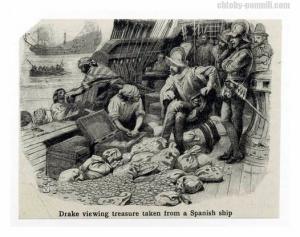Как таковой "морской униформы" в 16 в. ещё не существовало, но у моряков уже появился некий "морской стиль" одежды
И этот стиль опознавали визуально сразу и четко:
One has only to read Admiralty Court depositions to see that taverns figure largely as a popular haunt for seafarers. The search for employment was probably helped by the fact that seamen were recognized by their distinctive manner of dressing. A grocer and his apprentice who bought goods from two strangers took them to be seafarers because they wore "saylers apparell". An Admiralty officer who was looking to impress seamen for naval duty approached one John Richard on sight, presumably because of manner of dress.
И оттуда же об изнашивании, снабжении одеждой и о чистоте:
Contemporaries believed that seamen's lack of clothing was a contributing factor to their high rate of sickness. Richard Hawkins observed that it was "a common calamitie amongst the ordinary sort of Mariners, to spend their thrift on the shore, and to bring to Sea no more Cloaths then they haue backes ... ". Although the evidence of seamen's wills suggest that even the less affluent seamen brought more than one shift of apparel, there are frequent complaints from those in authority about the lack of seamen's clothing. Given that the shipboard duties of the majority of the crew were labour-intensive, seamen's clothing underwent a great deal of wear and tear. Raleigh estimated that a suit of apparel would be worn to shreds within six months at sea. Richard Hawkins maintained that wearing scant, wet, and salt-encrusted clothing was bound to upset the humours. Both he and John Hawkins provided clothing for their seamen but seamen on expeditions to locate the Northwest passage had to wait until 1602 to receive the first "Arctic kit", provided by the sponsor, the East India Company: leather mittens, leather breeches with fur, woollen hose and stockings, furred cassocks with hoods, and leather boots. It was not until the opening years of the seventeenth century that merchant companies and the navy began to recognize the need for improved measures.
Earlier in the sixteenth-century the state provided clothing for naval seamen. The men in Henry VIII's navy were allotted green and white coats at a cost of 34 pence each. This practice was discontinued in 1560. Unlike the men of the Elizabethan army who received both summer and winter issue at the joint expense of the Crown and the county, the Elizabethan navy granted its imprest seamen only a small sum as "coat and conduct" money. These funds were to be put towards travel costs and to buy apparel. It seems unlikely that money not eaten up in travel costs secured much protection against the elements. Richard Hawkins noted that, "That money which is wont to be cast away in Imprestes [cash advances on wages] might be imployed in apparel, and necessaries at the sea, and given to those that haue need, at the price it was bought, to be deducted out of their shares or wages at their returne..." The Lord Admiral recognized the association between clothing and the health of the men under his command: "It is like enough that the like infection will grow throughout the most part of our fleet; for they have been so long at sea and have so little shift of apparel, and so [few] places to provide them of such wants, and no money wherewith to buy it, for some have been - yea the most part - these eight months at sea. My Lord, I would think it is a marvellous good way that there were a thousand pounds worth or two thousand marks worth of hose, doublets, shirts, shoes and such like, sent down; and I think your Lordship [Lord Burghley] might use ... all expedition for the providing and sending away of such things; for else, in very short time I look to see most of the mariners go naked".
Although the ongoing need was acknowledged, it was rarely met. As in most things, the Crown only provided for naval seamen when the most dire of circumstances compelled it to act. As always, relief was sporadic; these ad hoc measures did not result in a comprehensive plan to improve the condition of seamen employed in the service of their sovereign. In general, if naval seamen were in need of clothing, they did without or fell prey to some enterprising official contractor, landlady or fellow seamen who sold them overpriced apparel on credit. It was not until the closing years of the war (when the period of greatest naval activity was past) that navy accounts show that the Crown made its most benevolent gesture: in 1602 canvas shirts, cotton waistcoats, caps, hose and "rugge" to make gowns were ordered.
Some advances were made in the area of shipboard and personal hygiene. The official orders show that the regulation of hygienic conditions (relative to the standards of the day) was instituted much earlier for private expeditions than in naval service. Sebastian Cabot's orders for the Company of Merchant Adventurers (1553) stressed the need for cleanliness throughout the ship "for the better health of the companie ..." . The 1557 instructions of a merchant fleet to Russia show a similar emphasis... Richard Hawkins maintained that a sanitary shipboard environment was a necessity... In the navy, however, orders specifically stating that warships
should be cleaned and washed do not appear until 1596...
Some masters and captains, even on privateering vessels, encouraged sanitary habits and personal tidiness by carrying soap and needles and thread for their men to wash and repair their clothes. Among the artifacts salvaged from the Mary Rose were combs and ear-scoops. Soap was carried aboard the early Elizabethan voyages to West Africa. As we have already seen, even sixteenth-century seamen had limits of tolerance. The crew of the True Love approached their master about the "stinche" of his apprentice which "greeved, troubled and annoyed" them. The offending boy was dunked into the sea and given a new suit of clothes.
![]()




















